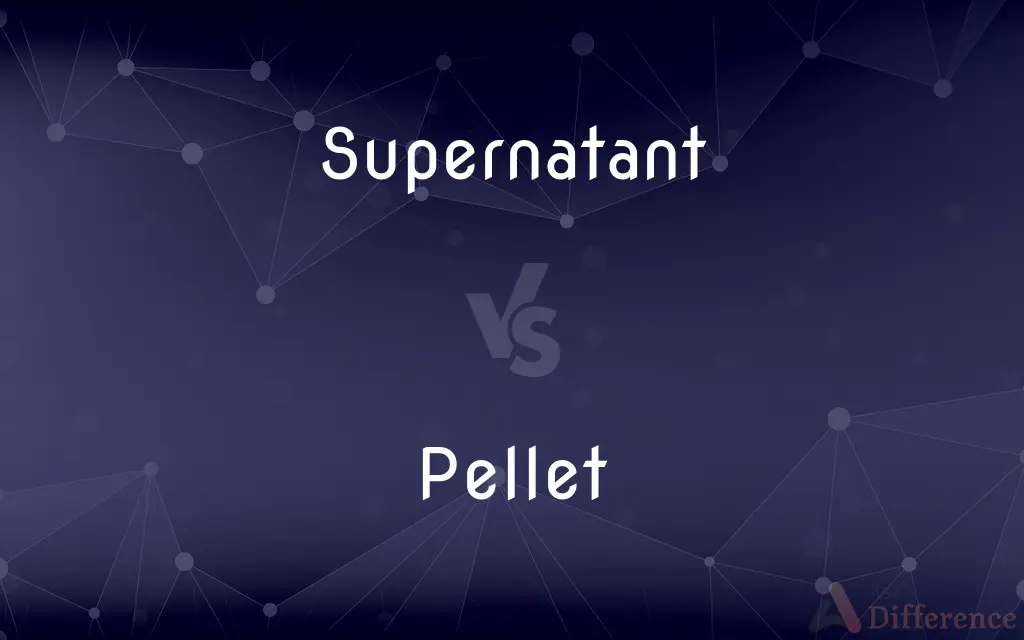Supernatant vs. Pellet — What's the Difference?
By Fiza Rafique & Urooj Arif — Updated on April 27, 2024
Supernatant is the clear liquid remaining after precipitates settle in a solution, whereas a pellet is the mass of settled particles at the bottom of the container.

Difference Between Supernatant and Pellet
Table of Contents
ADVERTISEMENT
Key Differences
In the process of centrifugation or sedimentation, the supernatant refers to the clear liquid that stays above the settled material, while the pellet consists of the denser materials that accumulate at the bottom of the container.
During laboratory experiments, the supernatant can be easily decanted or pipetted from the container, preserving the liquid for further analysis; on the other hand, the pellet, being solid, often requires resuspension or additional processing to be utilized further.
The supernatant typically contains dissolved solutes, remaining cells, or fine particles that did not settle, whereas the pellet is primarily composed of precipitated proteins, cells, or large particles that were the target of separation.
Analyzing the supernatant can help in understanding the soluble components of a mixture, whereas examining the pellet provides insights into the heavier, often more concentrated materials.
In terms of visibility, the supernatant is usually clearer and may range in color depending on the substances dissolved, while the pellet is generally more opaque and compact, visible as a distinct mass at the bottom.
ADVERTISEMENT
Comparison Chart
Definition
Clear liquid above settled material
Mass of settled particles at the bottom
Position in Container
Upper part
Lower part
Composition
Dissolved solutes, remaining cells or fine particles
Precipitated proteins, cells, large particles
Processing Needed
Can be decanted or pipetted
Requires resuspension or further processing
Visibility
Clearer, possibly colored
Opaque and compact
Compare with Definitions
Supernatant
Upper layer of a centrifuged sample.
The supernatant was clear, indicating no contamination.
Pellet
Concentrated mass of particles.
The pellet was dense, showing high purity of the sample.
Supernatant
Clear fluid above settled debris.
After centrifugation, the supernatant was collected for biochemical analysis.
Pellet
Settled material after centrifugation.
The DNA was found in the pellet after the spin.
Supernatant
Liquid remaining after precipitation.
The supernatant contained the necessary enzymes for the reaction.
Pellet
Residue left after decanting liquid.
The pellet contained all the cellular debris.
Supernatant
Decanted fluid from a mixture.
The supernatant was transferred to a new tube for further experiments.
Pellet
Solid deposit at the bottom of a container.
The pellet was washed twice before resuspension.
Supernatant
Separated aqueous phase.
The chemical assay was conducted using the supernatant.
Pellet
Accumulation of precipitate.
The pellet was analyzed to determine the concentration of the precipitated protein.
Supernatant
Denoting the liquid lying above a solid residue after crystallization, precipitation, centrifugation, or other process
Carefully transfer the supernatant fluid into a 15 ml centrifuge tube
Pellet
A small, solid or densely packed ball or mass, as of food, wax, or medicine.
Supernatant
A volume of supernatant liquid
The supernatants were filtered and analysed
Pellet
A bullet or piece of small shot.
Supernatant
Floating on the surface.
Pellet
A stone ball, used as a catapult missile or a primitive cannonball.
Supernatant
The clear fluid above a sediment or precipitate.
Pellet
To make or form into pellets.
Supernatant
Lying or floating above a denser fluid, or above a solid sediment or precipitate (which has been separated by crystallisation, centrifugation etc.).
Pellet
To strike with pellets.
Supernatant
The liquid that lies above a sediment or precipitate; supernate
Pellet
A small, compressed, hard chunk of matter.
A pellet of wood, paper, or ore
Supernatant
Material that floats on the surface of a liquid
Pellet
Compressed byproduct of digestion regurgitated by owls and many other birds of prey, which serves as a waste disposal mechanism for indigestible parts of food, such as fur and bones.
Supernatant
Swimming above; floating on the surface; as, oil supernatant on water.
Pellet
(heraldry) A roundel sable (black circular spot).
Supernatant
The liquid remaining after solids suspended in the liquid have been sedimented by gravity or by centrifugation. Contrasted with the solid sediment, or (in centrifugation) the pellet.
Pellet
One of the short conductive tubes in a Pelletron particle accelerator.
Supernatant
A liquid lying above a sediment (floating on the surface)
Pellet
To form into pellets.
Supernatant
Of a liquid; floating on the surface above a sediment or precipitate;
The supernatant fat was skimmed off
Pellet
To strike with pellets.
Pellet
A little ball; as, a pellet of wax on paper.
Pellet
To form into small balls; to pelletize.
Pellet
A small sphere
Pellet
A solid missile discharged from a firearm;
The shot buzzed past his ear
Common Curiosities
Can the supernatant be discarded in all experiments?
Not always; the decision to keep or discard the supernatant depends on the nature of the experiment and the components being studied.
Is it possible to have multiple pellets from one centrifugation?
Yes, if different materials settle at different rates, multiple pellets can form at different layers.
What is the primary use of the supernatant in laboratory settings?
The supernatant is often used to analyze soluble substances and remaining reactants in a solution.
What does the color of the supernatant indicate?
The color of the supernatant can indicate the presence of specific compounds or contamination levels.
How do you ensure complete separation of supernatant and pellet?
Careful centrifugation and proper decanting techniques are essential for clear separation.
What is the significance of analyzing both supernatant and pellet?
Analyzing both provides a comprehensive overview of all components in the mixture.
How do you typically process a pellet for analysis?
A pellet is usually resuspended in a buffer or solution to disperse the materials for further analysis.
What factors influence the formation of a pellet?
Factors include centrifugal force, time, temperature, and the density of the materials.
Can the supernatant contain any solid particles?
Yes, very fine particles can remain suspended in the supernatant.
How is the volume of the supernatant compared to that of the pellet?
The supernatant usually occupies a larger volume than the pellet, which is more condensed.
Share Your Discovery

Previous Comparison
Simple vs. Simpleton
Next Comparison
Meal vs. BreakfastAuthor Spotlight
Written by
Fiza RafiqueFiza Rafique is a skilled content writer at AskDifference.com, where she meticulously refines and enhances written pieces. Drawing from her vast editorial expertise, Fiza ensures clarity, accuracy, and precision in every article. Passionate about language, she continually seeks to elevate the quality of content for readers worldwide.
Co-written by
Urooj ArifUrooj is a skilled content writer at Ask Difference, known for her exceptional ability to simplify complex topics into engaging and informative content. With a passion for research and a flair for clear, concise writing, she consistently delivers articles that resonate with our diverse audience.
















































